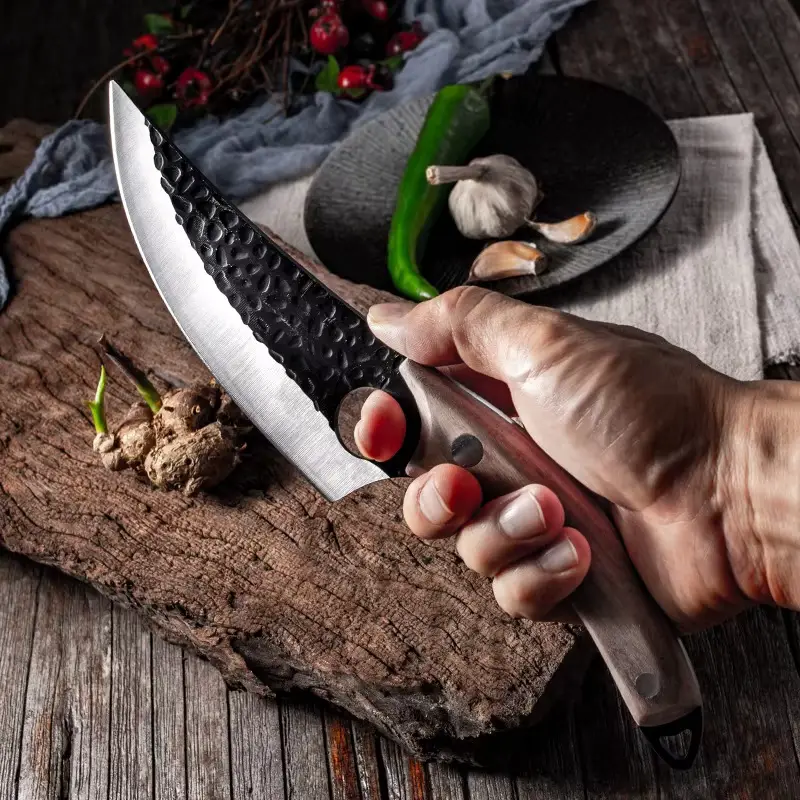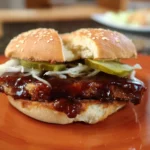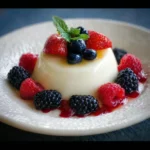Ah, Thai Coconut Ice Cream! The mere mention of it transports me back to bustling street markets in Bangkok, the sweet, fragrant aroma hanging in the humid air. My first taste was a revelation – intensely coconutty, incredibly creamy, yet refreshingly light, often served with an array of surprising and delightful toppings like sticky rice and roasted peanuts. I was instantly smitten. Recreating that authentic experience at home became a mission. After several attempts, tweaking ratios and ingredients, I finally landed on this recipe. The first time I served it to my family, their eyes widened. My kids, who can be picky, declared it “the best ice cream ever!” and even my usually reserved husband went back for seconds (and thirds!). It’s now a staple for hot summer days or whenever we crave a taste of tropical paradise. It’s dairy-free naturally, and the pure, unadulterated coconut flavour is simply divine.
The Unmistakable Charm of Thai Coconut Ice Cream
Thai coconut ice cream, or “i-tim kati” (ไอติมกะทิ) as it’s known in Thailand, is a world away from its Western dairy-based counterparts. Its signature characteristic is an intense, pure coconut flavour derived from rich coconut milk and often enhanced with tender strips of young coconut flesh. Unlike many commercial ice creams that rely heavily on dairy cream and eggs for richness, traditional Thai coconut ice cream often showcases the natural creaminess of coconut itself, making many versions inherently dairy-free.
What sets it apart is not just its primary flavour but also its texture and serving style. It tends to be slightly less dense than American-style ice creams and can sometimes have a subtly chewy or “sticky” quality, especially if made with a touch of tapioca starch or palm sugar, which adds a lovely caramel depth. In Thailand, it’s commonly sold by street vendors from carts, often scooped into half coconut shells, paper cups, or even between slices of soft bread like a sandwich. The array of toppings is part of the fun – from sweet sticky rice and roasted peanuts to candied palm seeds (attap chee), sweet corn, and a drizzle of evaporated or sweetened condensed milk. This recipe aims to capture that authentic essence, bringing a scoop of Thai street food magic to your kitchen.
Key Ingredients: The Soul of Authentic Thai Coconut Ice Cream
The beauty of Thai coconut ice cream lies in its simplicity, but the quality of each ingredient is paramount.
- Full-Fat Coconut Milk: This is the absolute star and non-negotiable for achieving that rich, creamy texture and intense coconut flavour. Look for brands with a high coconut extract percentage and minimal additives. Avoid “light” coconut milk, as it will result in an icier, less satisfying ice cream. Good quality canned coconut milk often has a thick layer of cream separated at the top – this is a good sign!
- Coconut Cream: For an even richer and creamier result, coconut cream (the very thick, solidified part of coconut milk, or sold separately) can be used in addition to or partially replacing coconut milk. It has a higher fat content, which contributes to a smoother mouthfeel and reduces iciness.
- Sweetener:
- Granulated Sugar: The most common and readily available sweetener. It dissolves easily and provides clean sweetness.
- Palm Sugar (Gula Melaka/Nam Tan Puek): For a truly authentic Thai flavour, consider using palm sugar. It comes in cakes or paste form and has a deep, caramel-like, slightly smoky flavour that beautifully complements coconut. It will give your ice cream a slightly off-white or beige hue. You’ll need to chop or shave it and ensure it’s fully dissolved.
- Corn Syrup or Glucose Syrup (Optional but Recommended for Texture): A small amount of liquid glucose or light corn syrup is often used in homemade ice cream. It helps prevent the formation of large ice crystals, resulting in a smoother, less icy texture, especially important since we’re not using eggs or lots of dairy fat as stabilizers.
- Tender Young Coconut Meat (Optional but Highly Authentic): Thinly sliced or shredded fresh young coconut meat adds a wonderful textural contrast and boosts the coconut flavour. You can buy whole young coconuts (often found in Asian markets) and scoop out the soft flesh, or sometimes find it frozen. If using, ensure it’s tender; overly mature coconut meat will be tough.
- Salt: A pinch of salt is crucial. It doesn’t make the ice cream salty but rather enhances the sweetness and balances the richness of the coconut.
- Tapioca Starch (Optional Thickener/Stabilizer): Some traditional recipes include a tiny bit of tapioca starch mixed with water to create a slurry. This is cooked briefly with the coconut milk base to thicken it slightly, which can improve the texture and “scoopability,” giving it a slightly chewier quality. This recipe doesn’t explicitly call for it to keep it simple, but it’s a traditional addition.
Avoid using desiccated or sweetened shredded coconut (baking coconut) in the ice cream base itself, as it can create a gritty texture. It’s better used as a toasted topping.
Ingredients for Authentic Thai Coconut Ice Cream
This recipe yields approximately 1 to 1.5 quarts of ice cream.
- 2 cans (13.5 oz / 400 ml each) full-fat coconut milk, preferably unsweetened and chilled (use a good quality brand)
- 1/2 cup (120 ml) coconut cream (the thick solid part from the top of a chilled can of coconut milk, or buy separately)
- 3/4 cup (150g) granulated sugar (or use 1/2 cup granulated sugar + 1/4 cup finely chopped palm sugar for more authentic flavour)
- 2 tablespoons light corn syrup or liquid glucose (optional, for smoother texture)
- 1/4 teaspoon salt
- 1 teaspoon pure vanilla extract (optional, not strictly traditional but many enjoy it)
- 1/2 cup tender young coconut meat, thinly sliced or shredded (optional, but highly recommended for authenticity)
Equipment:
- Ice cream maker
- Saucepan
- Whisk
- Freezer-safe container for storing ice cream
Step-by-Step Instructions to Tropical Bliss
Follow these instructions for a creamy, dreamy Thai coconut ice cream.
- Prepare the Coconut Meat (if using):
- If using a whole young coconut, carefully crack it open (there are many online tutorials for this). Pour out the coconut water (drink it – it’s delicious!).
- Scoop out the soft, tender white flesh using a spoon. Avoid any hard, brown husk.
- Thinly slice or shred the tender coconut meat. You should have about 1/2 cup. Set aside. If using frozen young coconut meat, thaw it and pat dry.
- Make the Ice Cream Base:
- In a medium saucepan, combine one can of the full-fat coconut milk, the coconut cream, granulated sugar (and palm sugar, if using), light corn syrup (if using), and salt.
- Heat the mixture over medium-low heat, stirring constantly with a whisk, until the sugar (and palm sugar, if used) is completely dissolved. Do NOT let the mixture boil. You just want it warm enough to dissolve the sugars and meld the flavours – around 160-170°F (71-77°C) is sufficient.
- Once the sugars are dissolved, remove the saucepan from the heat.
- Chill the Base:
- Stir in the second can of (chilled) full-fat coconut milk and the vanilla extract (if using). Adding the chilled coconut milk now helps to cool down the base faster.
- Pour the mixture into a clean bowl or container. Cover it with plastic wrap, pressing the wrap directly onto the surface of the liquid to prevent a skin from forming.
- Refrigerate the ice cream base for at least 4-6 hours, or preferably overnight, until it is thoroughly chilled (ideally to 40°F/4°C or below). This step is crucial for achieving a creamy texture when churning. Do not skip or rush this chilling process.
- Churn the Ice Cream:
- Once the base is thoroughly chilled, give it a quick whisk.
- Pour the chilled base into the frozen canister of your ice cream maker.
- Churn according to the manufacturer’s instructions, typically for 20-30 minutes, or until the ice cream is thick and has reached a soft-serve consistency.
- If using the tender young coconut meat, add it during the last 5 minutes of churning, or gently fold it in by hand once the ice cream has finished churning.
- Harden the Ice Cream:
- Transfer the churned ice cream to a freezer-safe container (pre-chilling the container in the freezer helps). Smooth the top with a spatula.
- Press a piece of parchment paper or plastic wrap directly onto the surface of the ice cream to prevent ice crystals from forming. Cover the container tightly.
- Freeze for at least 2-4 hours, or until the ice cream is firm enough to scoop. For best texture, allow it to harden for 6-8 hours or overnight.
- Serve and Enjoy:
- Before serving, you might need to let the ice cream sit at room temperature for 5-10 minutes to soften slightly for easier scooping, especially if it has been frozen solid overnight.
- Serve with your favourite traditional Thai toppings (see “How to Serve” section).
Nutritional Insights: A Tropical Treat
- Servings: This recipe makes approximately 1 to 1.5 quarts, which is about 8-10 servings (1/2 cup per serving).
- Calories per serving (approximate, for a 1/2 cup serving without toppings): Around 250-350 calories.
Please note: Nutritional information is an estimate and can vary significantly based on the exact brands of coconut milk/cream used, the amount of sugar, whether young coconut meat is included, and serving size. Toppings will add additional calories, fats, and sugars.
- Coconut Milk/Cream: The primary source of calories, mainly from saturated fats (plant-based medium-chain triglycerides, which are metabolized differently than some other saturated fats).
- Sugar: Contributes carbohydrates and calories.
- Naturally Dairy-Free and Vegan: This recipe, as written, is naturally dairy-free and vegan.
While indulgent, coconut milk offers some beneficial fatty acids. Enjoy this treat as part of a balanced lifestyle.
Time Commitment: Planning Your Ice Cream Adventure
Homemade ice cream requires some patience, mostly for chilling and freezing.
- Active Preparation Time (Making the base, preparing coconut meat): 20-30 minutes
- Chilling Time for Ice Cream Base: Minimum 4-6 hours, preferably overnight (8-12 hours) – Inactive time
- Churning Time: 20-30 minutes
- Hardening Time in Freezer: Minimum 2-4 hours, preferably 6-8 hours or overnight for best scoopable texture – Inactive time
Total Estimated Time: While active work is minimal (under an hour), plan for at least 8-12 hours from start to enjoying your first scoop, with most of that time being hands-off chilling and freezing. It’s best to make the base the day before you plan to churn.
How to Serve Thai Coconut Ice Cream: The Authentic Experience
Serving Thai coconut ice cream is an experience in itself, often involving an array of delightful toppings that provide contrasting textures and flavours.
- Traditional Thai Street Food Style:
- In a Young Coconut Shell: If you used fresh young coconuts, save the shells for an authentic serving vessel.
- Toppings Galore (Offer a selection):
- Roasted Peanuts: Roughly chopped or halved, unsalted or lightly salted, provide a wonderful crunch.
- Sweet Sticky Rice (Khao Niao Mamuang style, but just the rice): A small spoonful of warm or room temperature sweet sticky rice at the bottom of the bowl before adding the ice cream is classic.
- Toasted Mung Beans: Crispy, toasted yellow mung beans add another layer of crunch.
- Candied Palm Seeds (Attap Chee / Luk Chid): Translucent, chewy, and mildly sweet.
- Sweet Corn Kernels: Canned or freshly cooked, adds a surprising but pleasant sweetness and pop.
- Grass Jelly (Chao Kuai): Cubes of black grass jelly.
- Toddy Palm Fruit (Look Tan): Sliced, similar in texture to palm seeds.
- Nata de Coco: Chewy, translucent jelly-like cubes made from coconut water.
- Drizzle of Sweetened Condensed Milk or Evaporated Milk: Adds extra sweetness and creaminess (note: this makes it no longer dairy-free/vegan if using regular dairy milk).
- Modern Presentation Ideas:
- With Tropical Fruits: Serve alongside fresh mango, pineapple, lychee, or jackfruit.
- Toasted Coconut Flakes: For extra coconut intensity and crunch.
- Alongside Thai Desserts: Pair with mango sticky rice (Khao Niao Mamuang) or pandan-flavoured jellies or cakes.
- In a Soft Bun: Some vendors serve it in a hot dog-style bun, which sounds unusual but is a popular local treat!
- Simple & Elegant:
- Serve in chilled bowls or glasses.
- Garnish with a mint sprig or a lime wedge.
Encourage guests to customize their own bowls if offering multiple toppings – it’s part of the fun!
Additional Tips for Coconut Ice Cream Perfection
Achieve the creamiest, most flavourful Thai coconut ice cream with these pro-tips:
- Use High-Quality, Full-Fat Coconut Milk & Cream: This is the most critical tip. The fat content is essential for creaminess and preventing iciness. Don’t be tempted to use “light” versions. Brands like Aroy-D (in cartons for drinking/cooking, or cans), Chaokoh, or Thai Kitchen are generally good.
- Don’t Boil the Base: When heating the coconut milk mixture to dissolve the sugar, use gentle, medium-low heat. Boiling can sometimes cause the coconut milk to separate or develop an off-flavour.
- Chill the Base Thoroughly: An ice cream base that isn’t cold enough will take longer to churn, incorporate too much air, and may result in larger ice crystals, leading to an icier texture. Overnight chilling is best.
- Pre-Chill Your Freezer Container: Transferring the freshly churned soft-serve ice cream into a pre-chilled container helps it freeze faster and more evenly, which also helps minimize ice crystal formation.
- Work Quickly When Transferring and Freezing: Once churned, get the ice cream into its storage container and into the coldest part of your freezer as quickly as possible to prevent it from melting and refreezing, which can affect texture.
Frequently Asked Questions (FAQ) About Thai Coconut Ice Cream
Here are answers to common questions about making this delightful treat:
- Q: Can I make Thai coconut ice cream without an ice cream maker?
- A: Yes, you can! The texture might be slightly denser and potentially icier than churned ice cream, but it’s still delicious.
- Freeze and Stir Method: Pour the chilled base into a shallow, freezer-safe dish. Freeze for 45-60 minutes until the edges start to set. Remove and stir vigorously with a fork or whisk, breaking up any ice crystals. Return to the freezer. Repeat this process every 30-45 minutes for 3-4 hours, or until it reaches a scoopable consistency.
- Blender/Food Processor Method: Freeze the base in ice cube trays. Once frozen solid, transfer the cubes to a powerful blender or food processor and blend until smooth and creamy. You may need to add a tablespoon or two of coconut milk if it’s too thick to blend. Serve immediately as soft-serve or transfer to a container and freeze until firm.
- A: Yes, you can! The texture might be slightly denser and potentially icier than churned ice cream, but it’s still delicious.
- Q: Why is my homemade coconut ice cream icy instead of creamy?
- A: Iciness is usually due to large ice crystals forming. Common causes include:
- Not enough fat: Using light coconut milk or not enough coconut cream.
- Not enough sugar or sweetener: Sugar lowers the freezing point and helps create a softer texture. Corn syrup/glucose also helps inhibit ice crystals.
- Base not chilled enough: A warm base takes longer to freeze in the churner.
- Slow freezing: If your freezer isn’t cold enough or the ice cream takes too long to harden.
- Incorrect churning: Over-churning or under-churning can sometimes affect texture.
- A: Iciness is usually due to large ice crystals forming. Common causes include:
- Q: Where can I find young coconut meat and palm sugar?
- A: Asian supermarkets are your best bet for both fresh young coconuts (which you’ll need to open yourself) and jars/cans of pre-cut young coconut meat (often in syrup, rinse well) or frozen young coconut meat. Palm sugar (look for Gula Melaka or Thai palm sugar in cakes/discs) is also commonly found there or online.
- Q: How long will homemade Thai coconut ice cream last in the freezer?
- A: For the best flavour and texture, homemade coconut ice cream is best consumed within 1-2 weeks. Store it in an airtight container with plastic wrap pressed directly onto the surface to minimize freezer burn and ice crystal formation. After longer periods, the texture may become icier.
- Q: Can I use other types of sugar, like brown sugar or maple syrup?
- A: You can experiment, but it will alter the flavour profile. Brown sugar will add a molasses note, which could be pleasant but different from traditional Thai coconut ice cream. Maple syrup would also lend its distinct flavour. Palm sugar is the most authentic alternative to granulated sugar for depth of flavour. If substituting liquid sweeteners for granulated sugar, you might need to adjust the overall liquid content slightly.
This Thai Coconut Ice Cream recipe is more than just a dessert; it’s an escape to a tropical paradise. Enjoy the process of making it and the pure, blissful taste of authentic coconut goodness!
Print
Thai Coconut Ice Cream recipe
Ingredients
- 2 cans (13.5 oz / 400 ml each) full-fat coconut milk, preferably unsweetened and chilled (use a good quality brand)
- 1/2 cup (120 ml) coconut cream (the thick solid part from the top of a chilled can of coconut milk, or buy separately)
- 3/4 cup (150g) granulated sugar (or use 1/2 cup granulated sugar + 1/4 cup finely chopped palm sugar for more authentic flavour)
- 2 tablespoons light corn syrup or liquid glucose (optional, for smoother texture)
- 1/4 teaspoon salt
- 1 teaspoon pure vanilla extract (optional, not strictly traditional but many enjoy it)
- 1/2 cup tender young coconut meat, thinly sliced or shredded (optional, but highly recommended for authenticity)
Instructions
- Prepare the Coconut Meat (if using):
- If using a whole young coconut, carefully crack it open (there are many online tutorials for this). Pour out the coconut water (drink it – it’s delicious!).
- Scoop out the soft, tender white flesh using a spoon. Avoid any hard, brown husk.
- Thinly slice or shred the tender coconut meat. You should have about 1/2 cup. Set aside. If using frozen young coconut meat, thaw it and pat dry.
- Make the Ice Cream Base:
- In a medium saucepan, combine one can of the full-fat coconut milk, the coconut cream, granulated sugar (and palm sugar, if using), light corn syrup (if using), and salt.
- Heat the mixture over medium-low heat, stirring constantly with a whisk, until the sugar (and palm sugar, if used) is completely dissolved. Do NOT let the mixture boil. You just want it warm enough to dissolve the sugars and meld the flavours – around 160-170°F (71-77°C) is sufficient.
- Once the sugars are dissolved, remove the saucepan from the heat.
- Chill the Base:
- Stir in the second can of (chilled) full-fat coconut milk and the vanilla extract (if using). Adding the chilled coconut milk now helps to cool down the base faster.
- Pour the mixture into a clean bowl or container. Cover it with plastic wrap, pressing the wrap directly onto the surface of the liquid to prevent a skin from forming.
- Refrigerate the ice cream base for at least 4-6 hours, or preferably overnight, until it is thoroughly chilled (ideally to 40°F/4°C or below). This step is crucial for achieving a creamy texture when churning. Do not skip or rush this chilling process.
- Churn the Ice Cream:
- Once the base is thoroughly chilled, give it a quick whisk.
- Pour the chilled base into the frozen canister of your ice cream maker.
- Churn according to the manufacturer’s instructions, typically for 20-30 minutes, or until the ice cream is thick and has reached a soft-serve consistency.
- If using the tender young coconut meat, add it during the last 5 minutes of churning, or gently fold it in by hand once the ice cream has finished churning.
- Harden the Ice Cream:
- Transfer the churned ice cream to a freezer-safe container (pre-chilling the container in the freezer helps). Smooth the top with a spatula.
- Press a piece of parchment paper or plastic wrap directly onto the surface of the ice cream to prevent ice crystals from forming. Cover the container tightly.
- Freeze for at least 2-4 hours, or until the ice cream is firm enough to scoop. For best texture, allow it to harden for 6-8 hours or overnight.
- Serve and Enjoy:
- Before serving, you might need to let the ice cream sit at room temperature for 5-10 minutes to soften slightly for easier scooping, especially if it has been frozen solid overnight.
- Serve with your favourite traditional Thai toppings (see “How to Serve” section).
Nutrition
- Serving Size: one normal portion
- Calories: 250-350 calories.






